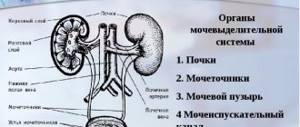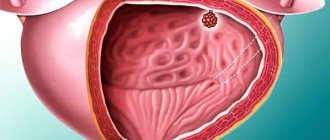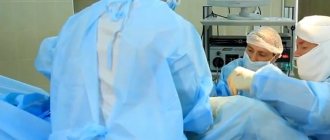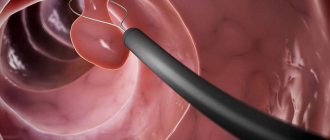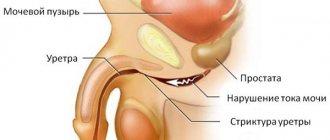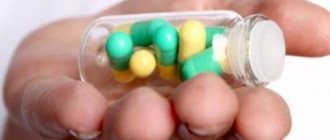Why is it carried out?
The procedure is prescribed to suppress the inflammatory process in the bladder and influence the bacterial flora. Instillation is recommended for the following diseases:
- cystitis;
- urethritis;
- prostatitis;
- genitourinary infections;
- bladder tumors.
The largest number of instillations is performed in patients with chronic, difficult-to-treat cystitis. Using this manipulation, malignant tumors are directly affected by vaccines, cytostatics, and radioactive drugs.
Manipulation is prescribed only by the attending physician after a thorough examination of the patient, determining indications and contraindications.
The essence and goals of the operation
The essence of this procedure is the drip administration of medication through the urinary canal. The operation is performed to eliminate damaged areas of the mucous membrane, and if the patient has a tumor, instillation of the urethra helps to destroy it.
This operation is also used as a treatment for infections in the lower urinary tract. The whole process takes no more than ten minutes, but after the medication is introduced into the body, it remains there for about an hour. Before starting the procedure, the patient’s bladder is emptied, the urethra and the skin around it are disinfected with an antiseptic. It is extremely dangerous to perform such an operation at home.
Features of instillations in women
The indication for the procedure in women is most often regular chronic cystitis or other diseases that lead to damage to the mucous tissues of the bladder. In order to speed up the process of mucosal restoration, in addition to the mandatory antibiotics, patients are prescribed infusions of healing and anti-irritation drugs.
Bladder instillation in women with chronic cystitis can reduce or stop taking antibiotics completely. Possible side effects include the development of individual intolerance to a number of components and the patient’s tendency to allergies.
The main tasks of instillations for chronic cystitis:
- reduction of inflammatory foci and irritation;
- restoration of mucous tissues of the urinary tract;
- elimination of infection.
In order for the procedure to have a therapeutic effect, the necessary diagnostic measures must be completed before the procedure.
To completely cure chronic cystitis, 7 to 10 procedures will be required. The duration of one session is determined individually depending on the general condition of the woman. If necessary or in case of relapse, the course of instillations is repeated after 1–2 months.
Instillation is a simple procedure for a urologist. You won't be able to do it yourself.
Special equipment and complete sterility conditions are required.
Before instillation, the patient must be prepared. This ensures maximum treatment effectiveness. First, the doctor prescribes a urine and blood test. The bladder is then examined using cystoscopy. If no contraindications are identified, medications are prescribed.
They arrive for the procedure at the specified time. Hygienic measures are mandatory. It is recommended to take a disposable sheet and towel with you. Women are advised to bring a sanitary pad so that droplets of liquid released do not stain their underwear.
Execution algorithm
Instillation of the bladder is carried out only in a treatment room. Absolute sterility is required. The manipulation is performed by a urologist, assisted by a nurse. Immediately before this, the patient should empty the bladder.
First, the entrance to the urethra is treated with an antiseptic. Then the doctor takes a sterile catheter and inserts it into the urethra and advances it to the bladder. The tip of the instrument is treated with anesthetic and petroleum jelly. This reduces pain when a hard object passes through the urethra.
Using a syringe through a catheter, the bladder is washed with an antiseptic solution warmed to room temperature. Then the necessary medicine is administered drop by drop. The catheter is removed and the patient cannot urinate for about 2 hours.
The procedure lasts 7-10 minutes, no more than 100 ml of the drug is infused. The course of treatment requires 8-10 manipulations, which are done every other day. The dosage is determined by the doctor individually, depending on the existing disease and the characteristics of the patient.
During the administration of the medicine, a burning sensation may occur. This is a normal condition that goes away in 10-15 minutes.
Several medications are needed for manipulation. To wash the bladder use:
- Chlorhexidine;
- Furacilin;
- Miramistin.
These are products with an antiseptic effect that cleanse the mucous membrane and prepare it for the application of medicine:
- For chronic bacterial cystitis, a colloidal silver solution is used - Protargol or Collargol. The drugs inhibit the proliferation of bacteria, thereby stopping the inflammatory process.
- Dimexide has an antimicrobial effect. It is used for cystitis and genitourinary infections. The substance also promotes healing of the mucous membrane.
- Antibiotics of the fluoroquinolone or macrolide group are used to treat chlamydia and ureaplasmosis. Instillations are made into the bladder, onto the back wall of the urethra.
- Bacteriophages are used when there is no response to antibacterial therapy. These drugs absorb microbes and cause virtually no side effects.
- Urolife is a solution of hyaluronic acid. The substance is used to heal the bladder mucosa in interstitial cystitis. This disease has no established cause and is characterized by the formation of erosions and ulcers on the wall of the organ.
- Imuran is a drug with a cytostatic effect. Suppresses uncontrolled cell proliferation. Used for malignant tumors of the bladder - cervical, parietal.
- Heparin is a direct anticoagulant. Stops bleeding, used for hemorrhagic cystitis.
- Vaccines with antitumor effects are prescribed for bladder cancer.
- Sea buckthorn oil has a healing effect. Used to treat cystitis with the formation of erosions after injuries.
- Lidase dissolves adhesions, that is, growths of connective tissue that should not exist in the cavity of a healthy organ.
All drugs are used in the form of ready-made sterile solutions.
The medicine should be warm, temperature 37-40 °C. When cold liquid is introduced, a spasm of the bladder occurs.
Representatives of the stronger sex more often undergo urethral instillation. Their urethra is long, narrow, and contains several bends. Because of this, microorganisms that cause urethritis and prostatitis multiply there more actively.
The male catheter is soft and elastic, without damaging the mucous membrane. Before the procedure, it is lubricated with lidocaine and a special gel that facilitates passage.
Ointments can be introduced into the urethra during instillation. They stay on the mucous membrane longer, providing a constant therapeutic effect.
What drugs are allowed to be used during instillation?
In order to effectively heal the mucous membrane, doctors use special medications in their treatment that have a quickly healing effect and also instantly relieve irritation. Antiseptics are often used, and oil-based solutions are used much less frequently.
When the disease has penetrated deep into the layers of the bladder, antibiotics are no longer able to have a therapeutic effect; in this case, Dimexide is prescribed, which relieves pain and promotes rapid healing of the affected mucosa.
For the chronic type of cystitis, Furacilin, Dioxidin, Hydrocortisone, Collargol, Potassium permanganate, as well as the well-known Protargol are prescribed.
Brief characteristics of Protargol
Protargol is a medicine that contains silver, due to which the product has good healing properties. Protargol is used for therapeutic treatment in urology, and is suitable for both adults and children.
The active substances in this product form a kind of protective film on the damaged shell. As a result, the vessels narrow and inflammation decreases. Silver ions do not allow the infection to pass further and destroy it completely. The use of Protargol does not cause addiction or side effects.
Collargol
This drug is also created on the basis of silver ions and has a high antiseptic effect. Collargol contains 70% silver and about 30% albumin, which connects silver molecules to each other. The drug perfectly heals, disinfects and relieves inflammation. Collargol is used for instillation of the urethra.
Properties of Dioxidine
The drug is considered a synthetic agent and has a bactericidal effect. When treating wounds with Dioxidin, the patient does not experience any pain. Damaged areas are well cleaned, and therefore rapid tissue restoration occurs.
Dioxidin has proven in numerous studies that it can destroy various types of microbes: salmonella, Vibrio cholerae, meningococci. This remedy has proven to be excellent for cystitis. Dioxidin is often used for instillation; it can only be used by adults.
The product should not be used during pregnancy or breastfeeding.
Procedure for women
In women it is usually performed for chronic cystitis. Due to the anatomical differences of the urethra, manipulation is easier and less painful than in men. The female urethra is wide and short, without bends.
Instillation is done on a gynecological chair. The patient is laid down, the urethra is treated with an antiseptic and a sterile metal catheter is inserted. Rinsing is done until liquid begins to pour out of the canal.
In pregnant women
It is not recommended for pregnant women to rinse their bladder. This carries a risk of damaging the uterus.
The drugs used, although slightly absorbed into the blood, can harm the fetus.
For the stronger half of humanity, instillations are most often prescribed for prostate diseases or urethritis. The anatomical structure of the male genitourinary system is much more complex than the female one, and therefore longer treatment is required.
With the development of inflammation, the depressions located in the urethra in men shrink, as if fencing off from the surrounding tissues. Thus protecting the body from the spread of infection. Standard treatment in the form of taking tablets does not always give the desired result, since the concentration of medications is not enough to reach all areas of the bladder affected by bacteria.
The main symptoms of prostatitis and urethritis in men are:
- frequent urge to urinate;
- it becomes painful when urinating;
- itching and burning occurs in the genital area;
- pain during sexual intercourse;
- potency becomes worse;
- blood or purulent inclusions may appear in the urine;
- urination becomes difficult, and the feeling of a full bladder does not leave;
- weakness, apathy and depression develop.
If you notice similar symptoms, consult a doctor immediately. It is easier to prevent a disease than to deal with the consequences.
Instillations at home for people with disabilities
Recently, due to the widespread use of lubricated catheters, some patients take full responsibility for their health and carry out bladder instillations themselves at home.
First of all, this is the category of people with disabilities who move in a wheelchair. Some of them do not have the ability to urinate on their own, and this becomes possible only with the help of a catheter. In addition, due to poor pelvic blood circulation, such patients often develop cystitis, which must be promptly treated by filling the bladder.
Therefore, many who are faced with this problem independently install a catheter and drain the urine into a urinal. And in the case of chronic cystitis, medicinal, antibacterial and healing solutions are administered in the form of instillations into the bladder.
Let's consider how it is possible to instill the bladder if it is not possible for people with disabilities to visit a medical facility for this purpose.
First, you need to thoroughly wash your hands with soap, use an alcohol- or chlorhexidine-based hand sanitizer, or carry out the procedure with sterile gloves.
Before starting the procedure, prepare everything you need:
- Cleanse yourself in the shower with a mild, pH-neutral intimate wash or baby wash with o.
- prepare a catheter of the appropriate size,
- urine collection bag (if it is not possible to urinate naturally before the procedure),
- wet wipes for intimate hygiene,
- bladder rinsing medication
- a medicine selected by the attending physician,
- Janet syringe or other suitable syringe for the catheter for administering the solution,
- dry napkin,
- holder-clip for underwear (for men),
- small mirror (for women).
Next, you can begin to unpack the catheter.
Connect the syringe with the solution and the catheter connector, then place it in a convenient sterile place.
Remove your underwear and position yourself in a comfortable position so that you can see the entrance to your urethra. Next, you need to treat the external genitalia and the entrance to the urethra with a sterile bandage with an antiseptic.
Then you need to remove the catheter from the package, but be careful that it does not touch clothing or skin, otherwise it will lose sterility and may become infected. If the catheter becomes unsterile, replace it with a new one.
Try to relax as much as possible and begin inserting the catheter while inhaling to make the catheter insertion process less sensitive.
Continue to slowly advance the catheter until you begin to urinate, and then some more. After draining the urine, stand up straight to make sure there is no more urine.
Next, you can begin the instillation procedure itself: using a syringe connected to a catheter, the necessary medicine is infused, also heated to room temperature, or better yet, to human body temperature. The medicine must be left in the bladder for some time, which is determined for you by your doctor.
At the end of the procedure, slowly and carefully remove the catheter from the urethra and discard it.
Let us remind you that it is not recommended to carry out catheterization and instillation on your own, and the information above is presented as additional auxiliary measures, for informational purposes only.
Possible side effects
Complications from instillation are rare. They are associated either with a person’s individual sensitivity to the drug, or with a violation of the manipulation technique. Possible complications:
- allergic reaction;
- bleeding;
- puncture of the bladder wall;
- infection of internal organs.
Against the background of frequent instillations, infection can spread to the kidneys - pyelonephritis develops.
There are several conditions that make the procedure impossible:
- acute cystitis;
- trauma to the urethral mucosa;
- narrowing of the canal;
- urinary tract tuberculosis;
- pregnancy.
In such cases, the risk of infection spreading increases and additional injury is possible.
The procedure is not performed on patients under the influence of alcohol or drugs or in acute psychosis.
Indications for installation in urology:
- chronic inflammation of the urethra and bladder;
- recurrent urinary tract infections;
- consequences of inflammation of the walls of the bladder and urethra;
- consequences of surgical treatment of bladder tumors.
Contraindications for instillation:
- urethral stricture;
- acute phase of inflammation with cystitis and urethritis;
- tuberculosis of the pelvic organs;
- allergic reactions to injected drugs.
The therapeutic effect is determined by the drug.
Who should not undergo this procedure?
Instillation, along with other types of therapeutic treatment, has some contraindications:
- inflammation of the reproductive system in extremely severe form;
- urethral injury;
- bladder tuberculosis;
- excessively narrow urethra;
- acute infections in the genitourinary system.
It has been clinically proven that this treatment method is quite effective and a positive result can be achieved in a short period of time. Instillation can solve a problem that is not amenable to general therapy, this has been proven by medical practice.
Diagnosis of cystitis
Diagnosis of cystitis includes clinical and laboratory tests. First, the doctor listens to the patient’s complaints and palpates his abdomen (when pressed, the patient experiences pain). Afterwards:
- General urine analysis (density, color and some other parameters are examined).
- General blood test (aimed at identifying symptoms of the inflammatory process - increased ESR and leukocyte levels).
- Blood biochemistry (the content of salts, protein, nitrates, etc. in the blood is determined).
- Urine culture to identify the causative agent of cystitis and determine its sensitivity to antibacterial drugs.
- Analysis for sexually transmitted infections (candidiasis, mycoplasmosis, trichomoniasis, ureaplasmosis, gonorrhea, gardnerellosis, chlamydia).
- Study of urine flow (uroflowmetry).
- Ultrasound of the kidneys, bladder (makes it possible to determine the size, shape and condition of the bladder and surrounding tissues).
- Urological examination.
- Cystoscopy with biopsy. A tube is inserted into the bladder, at the end of which a video camera is fixed. Using forceps, a piece of the organ wall is removed for subsequent examination under a microscope.
A full diagnosis of this common disease can be performed at any urology medical center.
How to properly prepare for instillations
To assess the feasibility and risks, the attending physician sends the patient for examination. First, it is necessary to conduct a general urine test with sediment microscopy and a general blood test with leukocyte count and ESR to assess the general condition of the body and understand the severity of the disease.
In most cases, the doctor prescribes cystoscopy - an examination of the inner surface of the bladder through the urethra under an endoscopic microscope.
a biopsy is required : a micropiece of tissue (slice) of the inner layer of the bladder is taken during cystoscopy and sent for tests to identify atypical (foreign) cells, as well as determine other indicators as prescribed by the doctor and determine the stage of the disease process.
The issue of performing cystoscopy (with or without anesthesia) and biopsy is decided individually with each patient.
Immediately before the procedure, preparation consists of completely emptying the bladder, toileting the genitals and taking a single dose of an antibiotic to prevent infection during the procedure. It is also recommended to take a disposable pharmacy diaper and towel with you.
Now let’s take a closer look at which drugs are used for the instillation procedure, and which ones should be avoided.
Procedure for women
Preparation for instillation:
- Take a shower and perform routine intimate hygiene procedures
- Natural way to release urine
If there are doubts about the advisability of the procedure, cystoscopy may be prescribed, but this is done at the discretion of the urologist.
Instillation has several positive qualities for which urologists love the manipulation:
- the ability to use high concentrations of the drug without the risk of side effects;
- prolonged presence of the drug on the mucous membrane of the bladder;
- effect in the deep layers of the organ wall.
Instillation also has a drawback. The procedure is invasive - instruments are inserted into the body cavity. This carries a risk of infection if items have not been adequately sterilized.
In municipal institutions, the possibility of infection from instruments is minimal; processing there is carried out under strict control.
Price
In public medical institutions, the procedure is performed free of charge if a person has indications for it.
Private clinics charge from 250 to 400 rubles per session. The price does not include medicine that the patient purchases independently.
In pregnant women
Preparations (chlorhexidine, protargol, collargol, silver ions and the like)
Chlorhexidine bigluconate is treated only locally.
This antiseptic is widely used for disinfection in surgical practice, dentistry and urology.
It is also widely used for infectious and inflammatory complications in gynecological practice.
Chlorhexidine is used to disinfect microtraumas (wounds, bites, scratches, burns).
With the help of chlorhexidine, sexually transmitted diseases (syphilis, gonorrhea, trichomoniasis, chlamydia and ureaplasmosis) are prevented.
It is instilled into the urethra and used for applications, irrigation and rinsing.
Protargol is used in ENT practice, ophthalmology and urology.
This is a drug containing silver ions.
It has anti-inflammatory, antiseptic and astringent effects.
It is widely used in urological practice for urethritis and cystitis.
Collargol also contains silver.
Unlike Protargol, in Collargol colloidal silver is in a very high concentration, up to seventy percent.
This drug also has an antiseptic effect.
Protargol and collargol contain silver, which is what their destructive effect on many pathogens is based on.
How and with what to treat cystitis
Antibiotics are used to prevent the spread of infection in cystitis. 3-7 day courses of antibiotic therapy are considered optimal. The best results can be achieved with antibiotics from the fluoroquinolone group. The rest, as practice shows, are not so effective against bacteria, which most often cause inflammation of the mucous membrane of the bladder.
If the patient suffers from severe pain, he is prescribed painkillers and anti-inflammatory drugs, for example, No-shpu, Baralgin, Papaverine, Nimesil, Diclofenac.
Herbal products are used in the treatment of cystitis in order to increase the amount of daily urine produced (diuretic effect). Today, the pharmacy offers industrial preparations made from plant materials. Among them are “Cyston”, “Fitolysin”, “Canephron”.
Since the course of the disease largely depends on the state of the immune system, patients can be prescribed immunomodulators:
- "Lycopid". Ensures the activity of cells that absorb and dissolve bacteria. Stimulates the production of antibodies against infectious agents.
- "Viferon". A drug based on interferon, a natural compound synthesized by the human body during infectious and inflammatory processes. Mobilizes the immune system.
- "Ura-Vaxom" (lyophilisate of 18 species of E. Coli bacteria). It has been proven that about 80% of cystitis is caused by the intestinal bacterium E. Coli. The introduction of Ura-Vaxom allows the immune system to very quickly form an adequate immune response.
Bladder instillation in the treatment of chronic cystitis in women and men
Bladder instillation is a procedure for introducing medications into the organ cavity. The method is aimed at local treatment of chronic cystitis. It is unpleasant for patients (especially men), but does not cause severe pain.
Instillation is carried out exclusively in a hospital setting. The bladder is first examined using an endoscope, an instrument equipped with an electron microscope. If necessary, a biopsy of the bladder wall is taken for histological analysis.
The technique for instilling the bladder is as follows:
- The bladder is emptied.
- A sterile urinary catheter is installed.
- The drug, heated to 370C, is slowly injected into the cavity using a special or injection syringe with a volume of 30-100 ml. After the cloudy solution has flowed out, the medicine is re-infused. This is done until clear liquid begins to flow out of the catheter.
- The catheter is carefully removed.
The patient is not recommended to urinate for an hour after completion of instillation. After 2-3 days, the procedure is repeated if necessary.
What drugs can be administered during instillation
During the treatment of chronic cystitis, the following compounds can be injected into the bladder through a catheter:
- antibiotics (aminoglycosides, penicillins, cephalosporins, etc.);
- antiseptics (“Furadonin”, “Dekasan”, “Chlorhexidine”, potassium permanganate, silver preparations, iodine, etc.);
- ozonated solutions (ozone is a powerful antioxidant);
- anti-inflammatory drugs (acetylsalicylic acid);
- herbal preparations (rosehip oil, chamomile decoction, sea buckthorn oil);
- immunostimulants (Interferon, Cycloferon, bacterial lysates);
- antispasmodic solutions (“Papaverine”, “No-shpa”);
- bacteriophages (taking into account the pathogen).
Contraindications to the procedure
Bladder instillation cannot be performed if:
- acute cystitis,
- tuberculosis of the genitourinary system,
- pregnancy (first trimester),
- acute infectious processes in the genitals.
Treatment of cystitis during pregnancy
Cystitis during pregnancy is quite common. It is dangerous because it can cause the development of pyelonephritis. Inflammation of the kidneys, in turn, is fraught with severe pregnancy, late gestosis, renal failure and other complications.
In the early stages, the symptoms of acute cystitis can be eliminated with the help of antibiotics - Amoxicillin, Monural, Suprax and some others. But many women do not want to take antibacterial drugs during pregnancy, especially in the first trimester. It should be noted that you can do without medications belonging to this group, but the treatment process will be delayed. In addition, the risk of relapse will always remain.
Herbal preparations that expectant mothers can take include Urolesan, Canephron-N, and Cyston. “No-spa” is indicated for severe pain symptoms.
In the later stages of pregnancy, bladder instillations and physiotherapy sessions can be performed.
What is instillation
This is an instrumental method of local impact on the bladder.
In this case, through a catheter located in the urethra, medicinal solutions are slowly introduced into the organ cavity. In other words, an intravesical infusion of medications occurs, called instillation, which means “drip administration.” This term should not be confused with "installation", which refers to the field of contemporary art. Each treatment method has its own advantages and disadvantages, the same applies to bladder instillations. Among the advantages of the method, which was introduced into clinical practice at the end of the 19th century in France, the following can be noted:
- local impact on the area affected by the pathological process;
- the low concentration of medicinal solutions turns out to be quite effective, since there is no partial “loss” of medications, which is inevitable when prescribing tablets and injections; at the same time, maximum concentrations can be used without fear of having a toxic effect on the entire body;
- the therapeutic effect of one dose of medication lasts for 2-3 hours;
- regeneration of the damaged mucous membrane occurs faster, which brings the patient’s recovery as close as possible;
- it is possible to use the method during pregnancy at any stage, which is more preferable than the use of other therapeutic methods, and contributes to the rapid disappearance of pathological symptoms.
Meanwhile, bladder instillation in women and men cannot be carried out under certain patient conditions. Thus, the presence of an acute inflammatory process or bleeding ulcers in the mucous membrane is a temporary contraindication. If the urethra has strictures (narrowings), then intravesical administration of drugs is also not indicated until the lumen of the urethra is corrected and its absolute patency is restored.
Clarification of indications and contraindications for intravesical treatment always occurs individually, only after final diagnosis and clarification of the presence of concomitant diseases. If this is not done, some complications may occur after the procedures.
Here are the most common of them:
- exacerbation of chronic recurrent cystitis;
- exacerbation of chronic urethritis;
- spread of infection ascending from the bladder and development of pyelonephritis (in the presence of vesicoureteral reflux).
Diet for cystitis
If you have cystitis, you should not eat foods that irritate the walls of the bladder. So, in the chronic form, you need to give up high-calorie and fatty foods, seasonings, sauces, and canned food. Acute cystitis “does not like” salt, alcoholic beverages, coffee, tea, smoked foods, pickled foods, seasonings.
A speedy recovery from inflammation of the mucous membranes of the bladder is promoted by:
- fruits vegetables;
- dairy products;
- liquid (cranberry juice, clean water);
- honey.
Indications and contraindications
Instillation is indicated if it is necessary to restore the mucous membranes of the bladder. The procedure is prescribed for various inflammations and cystitis, even in fairly advanced, chronic conditions. The method is also used to treat malignant tumors, quite successfully destroying cancer cells.
Procedures are prescribed only after diagnostics and examination of the genitourinary system with a cystoscope. If the oncological nature of the disease is suspected, a biopsy is additionally analyzed.
Despite the fact that bladder instillations for chronic cystitis are considered the most effective treatment, the acute form of the same disease is a complete contraindication to the procedure. Therapy is not allowed for inflammatory processes in the area of the external genitalia in women and for tuberculosis of the genitourinary system.
Is it possible to do it yourself?
At home, bladder instillation is strictly prohibited. This is fraught with dangerous consequences:
- damage to the urethra and bladder;
- bleeding;
- infection of internal organs.
Remember that correct instillation can only be done by a urologist using sterile instruments. It is strictly forbidden to pour herbal infusions and other folk remedies into the bladder.
Risk group for cystitis
The risk group for cystitis includes:
- girls who are just starting to be sexually active;
- pregnant women;
- women during menopause;
- elderly people;
- patients with diabetes;
- people with spinal cord injuries, multiple sclerosis, blockages of the urinary tract (kidney stones, tumors, polyps in the bladder, etc.);
- women using a contraceptive diaphragm who have anal sex.
Reviews from doctors
Urologists give positive reviews about instillation. The method of treating chronic cystitis and urethritis has good, lasting results. Patients have an ambivalent attitude towards manipulation. On the one hand, it leads to the healing of a person. On the other hand, the procedure itself is quite unpleasant, and it needs to be done several times.
I have been working as a doctor for a long time; in my practice there were many patients with chronic diseases of the bladder and urethra. Such problems are difficult to treat. But I really like using drug injections. This makes it possible to have a long-term effect on inflamed or injured mucous membranes. Recovery occurs several times faster. Instillation is especially suitable for women with chronic, indolent cystitis. Timely treatment allows you to avoid dangerous complications - kidney inflammation, urolithiasis. Anna Vladimirovna, urologist of the highest category
I often give directions for instillation. This is due to the fact that modern women often simply cannot find the time to get examined. At the first symptoms of cystitis, they take antibiotics on their own, which may not be suitable at all. This brings them to the gynecological chair. I have a positive opinion about the procedure itself. Yes, you will have to endure a little during it, but this is the minimum price for future health. Irina Nikolaevna, gynecologist
I suffered from cystitis for several years. It worsened as scheduled - in spring and autumn. No tablets, pastes, or herbal infusions helped. I was treated for a week, or even 10 days. One day, a urologist suggested taking a course of instillation of drugs directly into the bladder. Since I was already very tired of being sick, I agreed. The procedure was quite painful; first antibiotics were administered, then healing agents. In total, the course included 10 manipulations. I did them in the summer, and after about two months I was expecting another exacerbation. But he wasn't there. There was no relapse either in the spring or the next year. Thus, instillation helped cope with chronic inflammation of the bladder. Irina, 34 years old
I was diagnosed with chlamydia. The doctor explained that it was very difficult to treat. Antibiotics do not always help. To make them more effective, you need to insert them directly into the urethra. The procedure is unpleasant. They did it to me 10 times. Tests showed that the disease had disappeared. Alexander, 48 years old
I treated chronic cystitis with various drugs for a long time. There was little effect, and the doctor suggested a course of instillations. The manipulation was unpleasant for me, but quite bearable. First, rinsing was done, then an antibiotic was administered. Despite the full course, an exacerbation occurred a few months later. True, it was easier than in previous times. It may be necessary to repeat another course of treatment. Yulia, 42 years old
Instillation is an effective method of treating chronic diseases of the urethra and bladder. It is accompanied by some discomfort, but patients usually tolerate it well. The method allows you to speed up recovery and reduce the incidence of complications.
